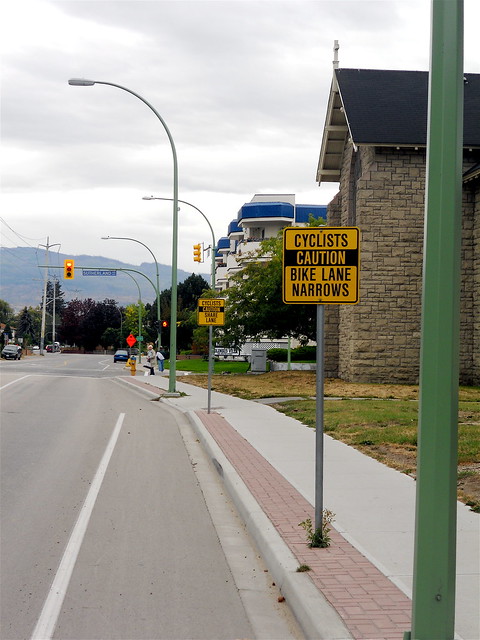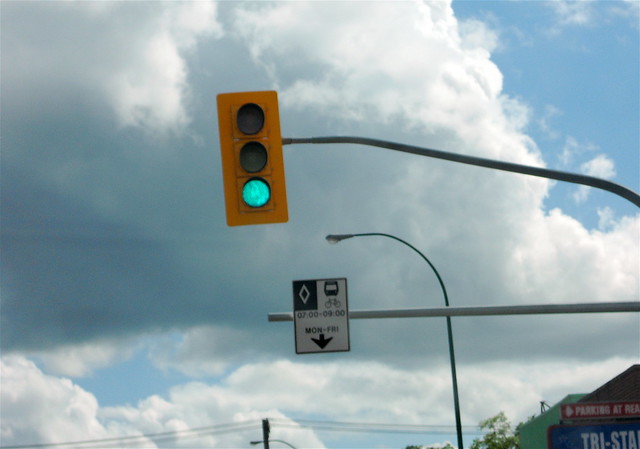
Editor’s note: this post originally appeared in Spacing Atlantic. The author makes several comparisons to cycling infrastructure in Halifax, but her observations will be familiar to Ottawa cyclists as well.
WESTERN CANADA – Most references to superior cycling infrastructure tend to default to the Netherlands, Portland, and — largely thanks to Gil and Enrique Penalosa — occasionally Colombia. While international models like these provide enough cyclist envy to fuel tense debates in a lagging city like Halifax, I have sometimes wondered why — outside of Montreal’s Bixi program — comparatively little celebration is made of Canadian cities’ own cycling victories… however small they might seem.
In the last three months I’ve been traveling Western Canada, my limitations as a non-driver have fluctuated between debilitating and a non-issue. Surprisingly, however, this fluctuation does not always correspond to city size. In even the most unexpected places, I’ve discovered bike-friendly features (albeit sometimes minute) that we’d benefit from across the country. Here’s a smattering of simple solutions we might learn from the West.
Vancouver, predictably, boasts a number of impressive features. Clearly labeled residential ‘bike routes’ throughout the city bolster cyclists’ confidence and help to guide newbies through less traffic-addled routes. What I like best, however, are certain areas where cyclists benefit from their own, cycle-sensible rules, as shown in the photo above. Tedious debate has depicted cyclists as dangerously straddling the line between pedestrians and drivers — picking and choosing which rules apply to us. Why not address this reality, and allow special rules in situations where cyclist behaviour is predictable? For example, here car traffic has to go around the block to get onto this residential street, while cyclists are granted the safe and instinctual route.
Kamloops — a city of approximately 85,000 in the south interior of BC — is one of those incongruous places where, while it’s chock full of outdoorsy and extreme sports types who’ll drive their bikes out to the surrounding hills on the weekends (often indulging in ‘freeriding‘, a daring activity that originated in Kamloops), the city itself is not cycling-forward. Hills, highways, and stunning sprawl stand ominously in the way of utilitarian cycling.
Nevertheless, the small downtown area is relatively bike-able, and home to one notable hidden gem: local bike-shop, The Bike Peddler. Part of the Community Living outreach program, this organization employs up to a dozen developmentally disabled men from the community, who fix up and sell second-hand and donated bikes. Further, under the guidance of manager Deborah Wickhorst, the shop also helps local police with enquiries into stolen bikes.
Heading southeast into the Okanagan Valley, Kelowna — which is marginally larger than Kamloops, and notably more touristy — boasts numerous bike lanes. Further adding to this infrastructure staple, signage — the lack of which I have long bemoaned in Halifax — provides proper warning to cyclists and drivers where lanes peter out.
Revelstoke, BC, is another ideal destination for the outdoors-obsessed, with sporting amenities of all types within reasonable reach. Here much aesthetic attention has been paid to street furniture and infrastructure, including bike parking. Unique, swoopy, wheel-hugging bike racks maximize the number of bikes that can fit into limited sidewalk space, and contribute to the Revelstoke brand. The obvious problem with these, of course, is the difficulty the design poses to locking both frame and wheel — a common criticism against Halifax racks as well. An ideal rack would balance this kind of sleek, space-saving design with theft prevention.
While not unique to Winnipeg, it was here I first encountered the shared bus and bike lanes known as “Diamond Lanes.” These aim to provide cyclists with respite from rush-hour traffic while simultaneously generating speedier transit service. Unfortunately, buses — in all their the vision-obscuring, exhaust-emitting, frequently-stopping glory — aren’t the friendliest of lane sharers, and the Diamond Lanes have received equal scrutiny and applause. Nevertheless, a lesson is to be learned here in prioritizing alternatives to the car.
As any cyclist will vouch, a little goes a long way. Through applying and adapting some of these basic features that cities across the country have already tried and tested, we might learn from each others’ experiences, reduce local troubleshooting, and build a national cycling culture.



